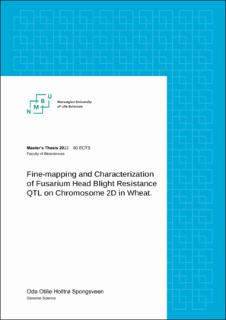| dc.contributor.advisor | Lillemo, Morten | |
| dc.contributor.advisor | Lin, Min | |
| dc.contributor.author | Spongsveen, Oda Otilie Holltrø | |
| dc.date.accessioned | 2022-10-31T08:22:35Z | |
| dc.date.available | 2022-10-31T08:22:35Z | |
| dc.date.issued | 2022 | |
| dc.identifier.uri | https://hdl.handle.net/11250/3028996 | |
| dc.description.abstract | Fusarium head blight (FHB) is a destructive disease in cereals (and other plants) caused by several plant pathogenic species of Fusarium spp. In bread wheat (Triticum aestivum) it infects the kernels, which greatly impacts the yield and grain quality. Additionally, certain species cause the production of mycotoxins after infections, which are detrimental to the health of humans and livestock. In this project, the focus was on resistance to Fusarium graminearum, one of the most common Fusarium pathogens in Norwegian wheat production.
The objective of this master project was to fine-map and characterize a resistance quantitative trait locus (QTL) on the long arm of chromosome 2D to further locate resistance gene(s) involved in FHB resistance. A BC1F7 mapping population was used, and the search for markers around the QTL of interest was narrowed down based on a literature study on previous QTL mapping studies. Our fine-mapping population was genotyped by these markers, and we investigated recombinations between these to further pin down the region of interest and get more knowledge on the markers. The second part of the project was a point inoculation experiment performed in greenhouse, with the goal of studying the phenotypic effect of the QTL and follow the disease development. Point inoculations allowed us to isolate the phenotypic effects of Type II resistance (resistance to spread within the spike) to FHB. From the QTL mapping we found three genetic markers (gwm539, WGRB3803, and wsnp_Ex_c8303_14001708) in our mapping population which were linked to the QTL. Based on field data from the years 2019, 2020, and 2021, the two markers gwm539 and WGRB3803 showed the most significant effect on phenotypic scores. From physical and linkage maps these two markers also appeared to be closest to each other, separated by an area of approximately 6 Mbp, a highly conserved distance among the sequenced pangenome varieties. Comparison of marker alleles in the published wheat pangenome indicated that Norin 61 could be used as a reference genome for this resistance QTL. The point inoculation experiment was also successful after optimizing the F. graminearum strains used for inoculum production, finding that aggressive isolates were essential for clear results. Additionally, the point inoculations revealed that there was a clear phenotypic difference between the two near isogenic lines (NILs) with and without the resistance QTL from our mapping population. However, the experiment on NILs with different recombinations between the three markers did not reveal any further details. Further experiments are needed to locate the resistance QTL more closely on chromosome 2DL; however, we have shown that point inoculation experiments can be a useful method for Type II resistance investigation of this QTL. | en_US |
| dc.description.abstract | Aksfusariose (Fusarium head blight, FHB) er en ødeleggende sykdom på korn og andre planter som forekommer etter infeksjon av ulike typer Fusarium spp. Når hvete blir infisert av denne soppen, har det en stor påvirkning på avling og kornkvalitet. Noen typer Fusarium produserer i tillegg mykotoksiner i kornet, som er skadelige for både menneskers og dyrs helse. I denne oppgaven var søkelyset på resistens mot Fusarium graminearum, som er en av de viktigste Fusarium-soppene i norsk hveteproduksjon.
Formålet med denne masteroppgaven var å finkartlegge og karakterisere et resistens «quantitative trait locus» (QTL) på den lange armen av kromosom 2D for å nærmere lokalisere resistensgen(er) involvert i Fusariumresistens. Kartleggingspopulasjonen som ble brukt var en BC1F7 populasjon, og leting etter markører i QTL-området ble avgrenset av et litteratursøk på tidligere QTL-kartleggingsforsøk på kromosom 2D. Markørene ble genotypet i kartleggingspopulasjonen, og deretter ble rekombinasjoner mellom markørene undersøkt for å videre plassere QTLet og finne ut mer om markørene. Den andre delen av masterprosjektet var å gjennomføre et punktinokuleringsforsøk i veksthus, der formålet var å undersøke den fenotypiske effekten av QTLet, samt å følge sykdomsforløpet. Ved å gjennomføre punktinokuleringsforsøk var det mulig å isolere kun Type II resistens (resistens mot spredning i akset). Fra QTL kartleggingen ble det funnet tre genetiske markører (gwm539, WGRB3803 og wsnp_Ex_c8303_14001708) i kartleggingspopulasjonen som var koblet til QTLet. Basert på feltdata fra 2019, 2020 og 2021, hadde markørene gwm539 og WGRB3803 mest signifikant effekt på fenotype-målingene. Utfra fysiske kart og koblingskart var det tydelig at disse to markørene er plassert nærmest hverandre, med en avstand på omtrent 6 Mb. Denne avstanden var konservert i alle de sekvenserte pangenomsortene. En sammenligning av markøralleler i det publiserte hvete-pangenomet tyder på at genomet til den japanske sorten Norin 61 kan bli brukt som et referansegenom for videre studier av QTLet på kromosom 2D.
Punktinokuleringsforsøket ble en suksess etter optimalisering av F. graminearum isolat, der vi oppdaget at et aggressivt isolat var essensielt for tydelige resultater. Punktinokuleringene viste at det var en tydelig effekt av resistens-QTLet i de to nærisogene linjene (NILs) med og uten resistens QTL fra kartleggingspopulasjonen vår. NILs med rekombinasjoner mellom de tre markørene, derimot, viste ingen tydelige resultater. Videre eksperimenter kreves for å plassere QTLet nærmere på kromosomet, men vi har funnet ut at punktinokuleringsforsøk kan være en nyttig metode for å undersøke Type II resistens på dette QTLet. | en_US |
| dc.language.iso | eng | en_US |
| dc.publisher | Norwegian University of Life Sciences, Ås | en_US |
| dc.rights | Attribution-NonCommercial-NoDerivatives 4.0 Internasjonal | * |
| dc.rights.uri | http://creativecommons.org/licenses/by-nc-nd/4.0/deed.no | * |
| dc.title | Fine-mapping and characterization of fusarium head blight resistance QTL on chromosome 2D in wheat | en_US |
| dc.type | Master thesis | en_US |
| dc.description.localcode | M-GS | en_US |

